(This is the paper I prepared for the Aviation Cultures VI conference held on-line in July 2022. It is a summary of the story told in my book, Western Airways.) (A PDF copy of the paper is available here)
This paper summarizes the results of research conducted into the creation of an aviation industry in Western Australia between the World Wars. It does not deal with events that captured the public imagination such as the Coffee Royal affair of 1929 or the Bertram and Klausmann search of 1932 but with the day-to-day business that led to the establishment and maintenance of an aviation industry in Western Australia. For the sake of convenience these activities have been divided into several themes but it should be remember that many of these developments occurred concurrently and influenced each other.
ABOUT WESTERN AUSTRALIA
The State of Western Australia occupies about one third of the Australian landmass, in the order of 2.5 million square kilometers. It is isolated from the rest of the world by vast oceans to the south and west and Australia’s great inland deserts to the north and east. It was founded as a British colony in 1829 but the white invaders found it generally desolate and significant growth did not take place until the gold rushes to the Eastern Goldfields and concurrent depression in the Australian eastern colonies in the 1890s led to a major influx of migrants. In the decade of the 1890s the white Western Australian population trebled to almost 180,000 in 1900.
The major white settlement occurred in the more fertile south western corner of Western Australia where the capital of Perth was also founded. Until the gold rushes the colony’s main industry was pastoralism with large inland holdings served by a number of ports on the coast that were served, in turn, by shipping linking to Perth and the outside world.
Western Australia joined the Commonwealth of Australia when it was established in 1901, ceding responsibility for matters such as defense, international affairs and posts and telegraphs to the Commonwealth government but retaining control over many other matters including health and transport. (This division of responsibilities caused some problems for aviation during the period between the wars that need not detain us here).
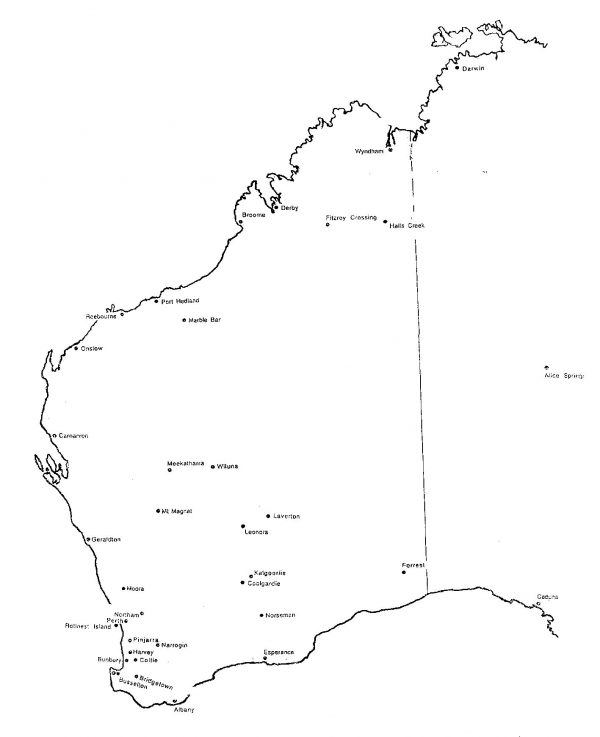
Becoming a part of the nation of Australia did little to relieve the sense of isolation felt by Western Australians – either externally in their relations with the eastern states or the rest of the world, and isolation from each other in the vast distances of Western Australia itself. Journeys to and from the far reaches of the State could take a couple of uncomfortable weeks, travel to the eastern states took about a week and travel to the center of the British Empire in London took around a month. Aviation was ideally suited to diminish this feeling of isolation when it came to Western Australia at the end of 1919.
PIONEERING
Norman Brearley brought aviation to Western Australia when he returned from the war with two Avro 504 light aircraft in 1919. He began in Perth with flying displays and selling joy rides and then extended his activities to country towns, followed by more extensive tours to more distant locations including Albany in the south, Kalgoorlie in the east and Onslow in the north. By the end of 1920 he was preparing to extend his business into other areas.
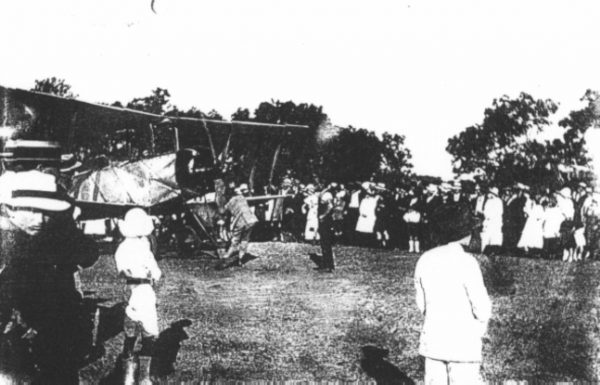
Brearley at Bunbury, 1919
GOVERNMENT SUPPORT AND ADMINISTRATION
After the First World War the Commonwealth government took responsibility for aviation and established a civil aviation administration (within the Department of Defense) and the Royal Australian Air Force, both in March 1921.
The civil aviation administration was responsible for enforcing the regulations regarding civil aviation operations and safety, providing facilities and services for civil flying such as aerodromes, airways and meteorlogical information, and advising the government on civil aviation policy including subsidies for aviation services. The Commonwealth government provided subsidies and other support for scheduled airline services – mainly for the carriage of air mail – and some other limited aviation activities.
The civil aviation administration was responsible for providing and maintaining the major aerodromes and other related aviation facilities in Western Australia. Apart from occasional visits by officials from the eastern states, aviation in Western Australia was largely self regulated until July 1931 when the civil aviation administration’s first Inspector was stationed there. This caused some conflict with the locals who had gotten used to doing things their own way.
The State government established a Transport Regulation Board in 1934, mainly to protect its railway system from encroaching road transport. This had little real effect on most civil aviation in Western Australia, apart from taxes and paperwork, but it did limit some airline flying in the Eastern Goldfields.
AIRLINE ACTIVITY
Australia’s first schedules airline service was established in Western Australia, starting in 1921 and operated by Western Australian Airways (later West Australian Airways) which was founded by Norman Brearley. The subsidized service was along the north-west coast from Geraldton to Derby. It linked the coastal settlements there with a weekly air mail, passenger and freight service. The return flight took six day, flown in stages first using the two passenger Bristol Tourer which was replaced by the four passenger deHavilland DH-50 from 1924. The route was extended south to Perth in January 1924 and north to Wyndham in July 1930. It was very successful and the traffic on it far surpassed the usage of the eastern states subsidized air services of Australian Aerial Services and QANTAS.
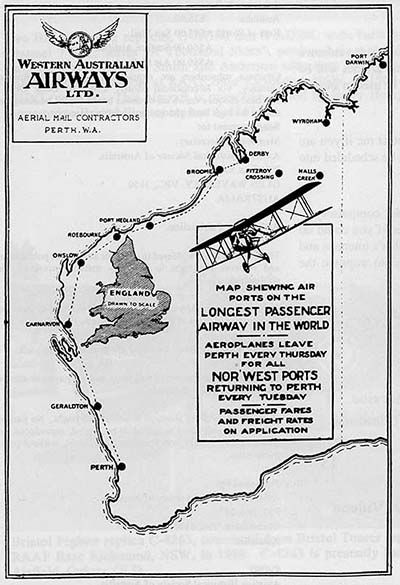
Western Australian Airways publicity c.1924
In June 1929 Western Australian Airways commenced a weekly subsidized air mail service between Perth and Adelaide which was designed to reduce by a week the time it took for mail from Britain to reach the eastern states. Initially the flight took two days, stopping at an aerodrome and hostel at Forrest overnight. It was not a financial success but continued nevertheless.
MacRobertson Miller Aviation Services replaced West Australian Airways on the north-west coastal route in October 1934 and in July 1936 Adelaide Airways (soon to be amalgamated into Australian National Airways) took over the Perth-Adelaide service. ANA steadily improved the service and, from July 1939, that airline offered three return flights a week between Perth and Melbourne using fourteen passenger DC-2s.
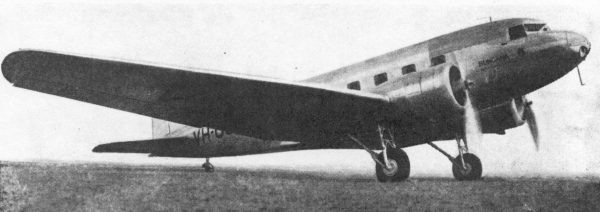
ANA’s DC-2 on the Perth-Adelaide service
After several attempts to establish a scheduled airline service serving Western Australia’s Eastern Goldfields, Airlines (WA) was founded by Charles Snook and commenced a regular service on that route in late 1935. Even with a small government subsidy it struggled to survive due to the limited traffic, long route distances and difficulties in finding aircraft suitable for that route.
FLYING CLUBS
In 1925 the Commonwealth government decided to encourage civil flying through support of a flying club movement and loaned flying clubs deHavilland DH-60s light aircraft and paid subsidies for training pilots to private pilot standard. As there was no aero club in Western Australia at the time Western Australian Airways established the Perth Flying School in April 1927 which initially played the role of a flying club until that role was taken over by the Western Australian Aero Club in April 1930
From it’s base at the government’s Maylands aerodrome in Perth the Aero Club promoted civil flying with air shows, displays, competitions and social activities. By the late 1930s it was well established.
As the possibility of war loomed in the late 1930s the government and the Aero Club gave more emphasis to pilot training and established branches in several regional centers to train pilots there. Due to the way in which the government’s subsidies were paid this resulted in several small clubs then being formed. However, all subsidized aero club flying wound up soon after the beginning of the Second World War due to the government’s changed pilot training policies.
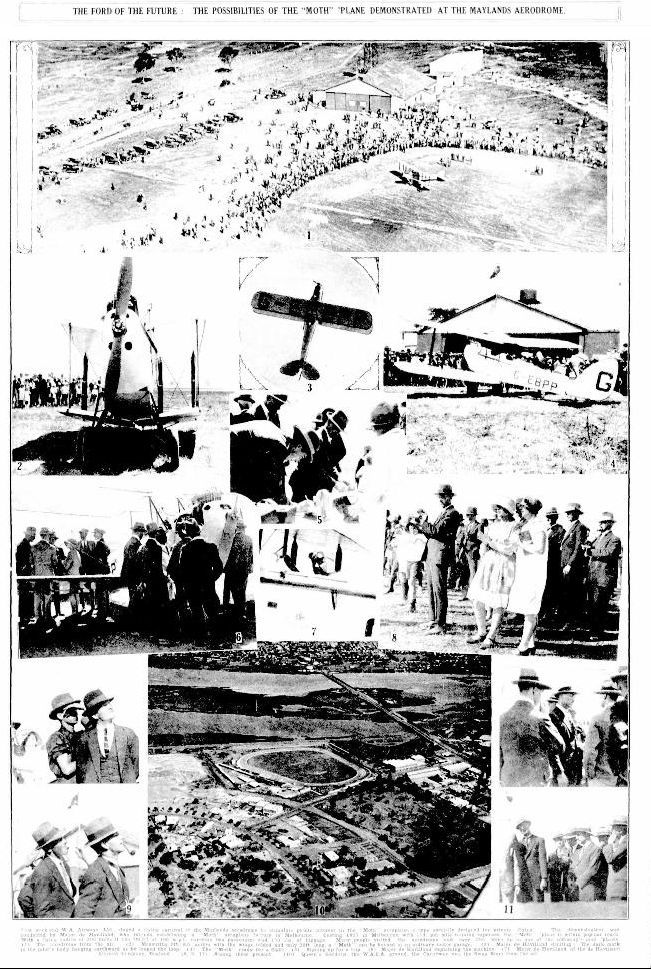
Flying display at Maylands Aerodrome (Western Mail photospread 17 February 1927)
UNSUBSIDIZED FLYING
Towards the end of the 1920s civil flying had become popular in Western Australia and a number of small companies were established offering aviation services ranging from joy-riding to airline services. These companies were (in order of formation) the Aerial Commerce Company, Seaplanes Limited, National Airways Limited, Western Aerial Services Limited, Wings Limited, Baker Aviation Company, Goldfields Air Navigation Limited, Air Taxis, and Avi-Tours Aeroplane Company of WA.
However, the onset of the Depression wiped out most of them, some without having never owned or flown an aircraft. Some survived for a few years but eventually they all went under. The most hardy of them was run by H C Ittershagen who established the Aerial Commerce Company. Among other things he set up an independent aerodrome at Subiaco where he ran the unsubsidized Subiaco Aero Club and flying school and held flying displays for several years until 1933.
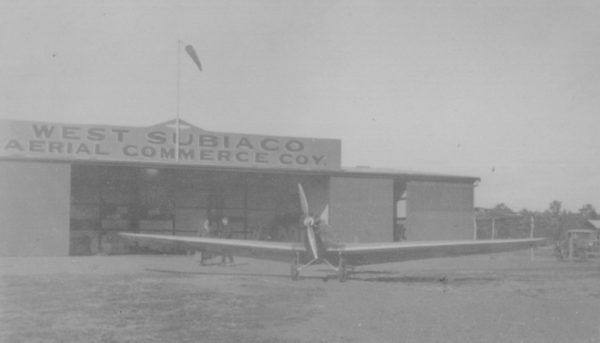
Aerial Commerce’s hangar and aircraft at the West Subiaco Aerodrome c.1932
By the mid 1930s there were only a couple of unsubsidized aircraft flying in Western Australia. One was owned by Vivian James whose James Taxi Planes offered a joy riding and charter service from Maylands aerodrome with a deHavilland DH-83. The other was George Lewis who established Goldfields Airways and offered a similar but larger service based in Kalgoorlie, beginning in August 1934. On several occasions Lewis tried to move in on Airlines (WA)’s route or establish new routes, but was blocked by Commonwealth and State authorities or because the proposed routes were unviable without a subsidy.
PROMOTING AVIATION
To encourage boys’ interest in aviation the Western Australian aviation industry, media and retailers promoted the hobby of making model aeroplanes with radio broadcasts, articles and plans in newspapers and clubs and competitions. By the end of the 1920s the Model Aero Club of Western Australia had over 200 members.
Since flying was such an expensive activity the idea of gliding became popular towards the end of the 1920s as an inexpensive way of introducing boys and young men to flying. In November 1930 the Model Aero Club called a meeting of those interested in forming a gliding club in Western Australia and idea spread rapidly, also promoted actively by media. A number of gliding clubs sprang up in Perth and rural areas with the plan that the group would build their own glider from plans and then take turns at flying it. This did not work out well in practice so most of these clubs soon disappeared. In 1933 the West Australian Flying Club (successor to Ittershagen’s Subiaco Flying Club) bought out all the gliding clubs around Perth and was granted land by the council at City Beach for its gliding activities.
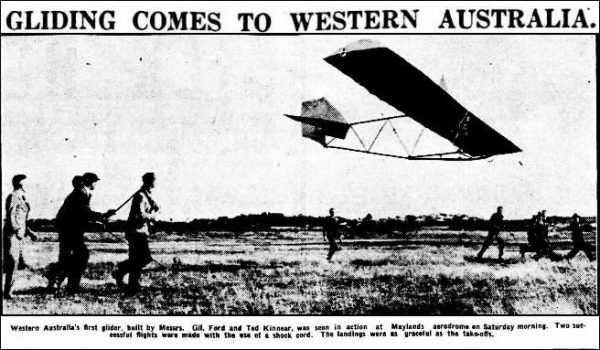
The first glider flight in Western Australia (West Australian, 15 December 1930)
FLYING DOCTOR SERVICES
During the 1920s Western Australian airlines and Aero Club occasionally flew medical patients and accident victims from remote areas to medical care so that value of aviation was well known. The Reverend John Flynn suggested the formation of a flying doctor service in Western Australia in 1925 but lack of fund prevent it from being established. The idea was raised again in 1929 but the onset of the Depression delayed plans for flying doctors in Western Australia until 1934.
As well as suitable aircraft the success of a flying doctor service depended on the creation of a network of radio stations including a large base station connecting with remote stations using Traeger’s pedal wireless. Establishing the radio networks and hiring or buying aircraft and staff was very expensive and required government subsidies and substantial charitable donations. A national organization, the Australian Aerial Medical Services (AAMS, later renamed the Royal Flying Doctor Service), with state branches was established to support these bases. The first bases in Western Australia were established at Port Hedland and Wyndham. The Port Hedland base was supported by the Perth Branch of the AAMS and the Wyndham base by the Victorian Branch which, at that time, did not see the need for a flying doctor in Victoria. Services at both bases started in the second half of 1935. George Lewis started a flying doctor service in Kalgoorlie that he later passed to the Kalgoorlie Branch of the AAMS. By 1941 there were 86 pedal wireless stations in contact with the three base stations in Western Australia; 43 with Wyndham, 37 with Port Hedland and six with Kalgoorlie.
AERIAL SURVEYING
Aerial surveying played an important part in the development of Western Australia. This was sometimes as simple and informal as a farmer or pastoralist chartering an aircraft so they could view their property from the air. More formally, in the mid 1920s the City of Perth commissioned an aerial survey which was conducted by Brearley’s Western Australian Airways with one of its aircraft equipped for the work.
In 1934 the newly created Western Mining conducted extensive aerial surveys of 88,000 square miles around the Eastern Goldfields using two specially equipped deHavilland DH-84s and ground parties to identify potentially worthwhile locations. The chief pilot in this enterprise was Charles Snook who established Airlines (WA) when the survey was complete.
Between 1935 and 1937 the RAAF conducted am extensive aerial survey of Northern Australia including the northern regions of Western Australia.
MILITARY AVIATION
The Royal Australian Air Force had no permanent presence in Western Australia for most of the interwar period. Air force planning in 1928 included the establishment of a squadron of aircraft in Perth and construction of a flying boat slipway at Albany but the Depression halted those plans. Small air force detachments visited Perth a few times in the 1930s to participate in flying displays and give a little training to Western Australia’s militia forces. In their absence the Aero Club formed a section which flew in co-operation with the local army during exercises to give personnel some experience of coping and co-operating with aircraft.
In 1935 the Commonwealth bought 500 acres of land at Bullsbrook north of Perth for the construction of a self contained air force base there. Work progressed over the following several years and the first RAAF aircraft, Avro Ansons, arrived there in October 1937. The first RAAF squadron, No 23 (City of Perth) Squadron (later renumbered as 25 Squadron) arrived in March 1938. With war looming a second squadron, 14 Squadron equipped with Lockheed Hudsons, was located at the base in March 1939. During this build up forward operating bases were prepared at places around the Western Australian coast and aircrew gained experience in flying in the state. By December 1941 there were 86 military aircraft in Western Australia.
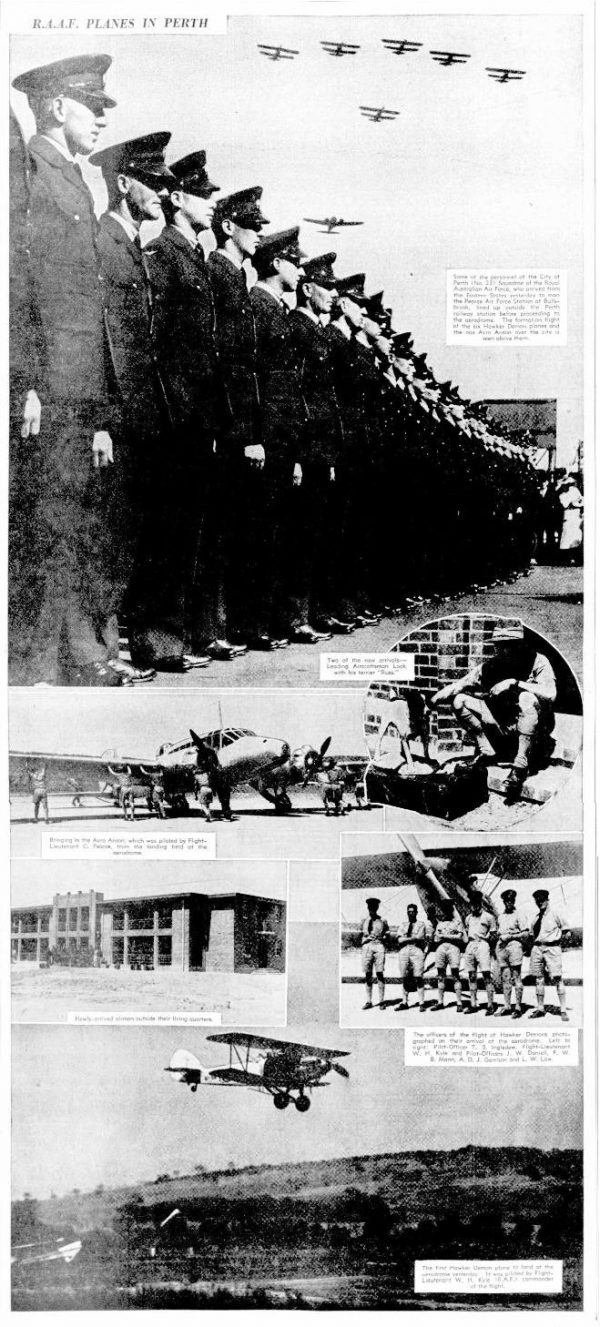
The RAAF arrives in Perth (West Australian 11 March 1938)
SUMMARY
By the end of the 1930s aviation, civil and military, had begun to reshape Western Australia. It had two squadrons of air force aircraft helping to defend it and a civil aviation infrastructure that would be important to defense when war broke out.
Civil aviation had helped to reduce the sense of isolation with the flying doctor service in remote areas and regular airline services connecting some of its more important towns, connecting it to the eastern states within a day’s flight and the center of the Empire, London, only a few days flight away. The activities of the airlines, aero clubs, private aviators and the RAAF had all combined to make Western Australians more airminded and less isolated from the outside world.
Leigh Edmonds
June 2022